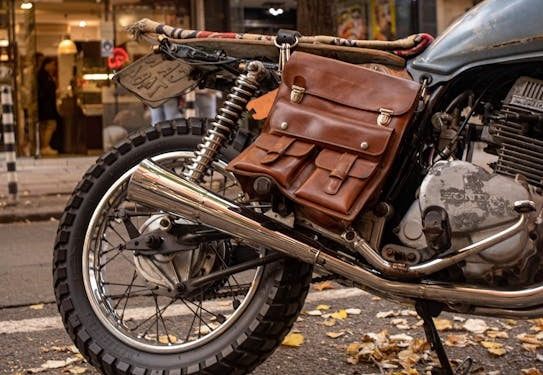Leather saddlebags are a must-have accessory for many motorcycle enthusiasts. They not only add a rugged charm to your bike but are also incredibly functional, providing ample storage space for personal items while on the road.
However, like any leather product, saddlebags require proper care to maintain their durability, appearance, and functionality over time. Without regular maintenance, exposure to the elements and wear can cause the leather to deteriorate, crack, or fade. In this guide, we’ll dive deep into the essentials of saddlebag care, including cleaning, conditioning, and preserving the leather for long-term use.
Understanding Your Saddlebags
Before diving into the cleaning and conditioning process, it’s essential to understand the type of leather your saddlebags are made from and how it reacts to different conditions.
Types of Leather Used in Saddlebags
Leather saddlebags are typically made from one of the following types of leather:
- Full-Grain Leather: This is the highest quality leather, known for its durability and natural appearance. It develops a rich patina over time, giving it a unique character.
- Top-Grain Leather: Slightly lower in quality than full-grain, top-grain leather is more uniform in appearance because it's sanded and treated to remove imperfections.
- Corrected-Grain Leather: This leather has been heavily processed and treated to give it a uniform texture. While it’s more affordable, it’s less durable and can be prone to cracking.
- Split Leather: This leather comes from the lower layers of the hide and is usually used for budget-friendly saddlebags. It's less durable but can still look good with proper care.
How Exposure Affects Leather
Leather is highly affected by external factors such as:
- Sunlight: Prolonged exposure can cause leather to fade and dry out.
- Rain and Moisture: Water can cause stains and lead to mold or mildew if not dried properly.
- Dust and Dirt: Over time, these can settle into the pores of the leather, dulling its appearance.
Understanding how these factors impact your saddlebags will help you tailor a care routine that keeps them in top condition.
Materials Needed
To properly clean and condition your leather saddlebags, you’ll need the following materials:
- Soft Microfiber Cloths: These are gentle on the leather and help avoid scratches.
- Leather Cleaner: Look for pH-balanced products designed specifically for cleaning leather.
- Leather Conditioner: Helps moisturize and protect the leather, keeping it soft and preventing cracks.
- Soft Bristle Brush: Useful for removing dirt from crevices.
- Mild Soap (if necessary): Use a mild soap in cases of heavy dirt buildup, but ensure it's leather-safe.
- Water: Lukewarm water is ideal for gently cleaning the surface without causing damage.
Make sure to avoid harsh chemicals or petroleum-based products, which can break down the leather fibers over time. Instead, opt for eco-friendly and biodegradable products whenever possible.
Cleaning Process
Cleaning leather saddlebags is a multi-step process that requires attention to detail. Regular maintenance will ensure that dirt and grime don’t settle into the leather, leading to long-term damage.
Step-by-Step Cleaning Guide
- Dust Off the Surface: Begin by dusting off your saddlebags using a dry, soft microfiber cloth. This removes loose dirt and debris.
- Prepare the Cleaner: Dampen a microfiber cloth with lukewarm water and apply a small amount of leather cleaner to it. Be sure not to over-saturate the cloth, as excess moisture can harm the leather.
- Clean the Leather: Gently rub the leather in circular motions, paying extra attention to areas with stains or dirt buildup. Avoid scrubbing too hard, as this can damage the leather’s surface.
- Address Stubborn Stains: For tougher stains, use a soft bristle brush dipped in the leather cleaner. Make sure to be gentle to avoid scratching the leather.
- Rinse (if needed): Depending on the cleaner, you may need to rinse off any excess product. Refer to the cleaner's instructions to avoid leaving residue.
- Dry Thoroughly: Allow the leather to air dry completely before moving to the next step. Never use direct heat, as it can cause the leather to crack.
Regular vs. Deep Cleaning
For regular maintenance, a simple dusting and light cleaning once a month will suffice. For deep cleaning, it’s recommended to do this every 3-4 months, depending on usage and exposure to elements.
Drying and Conditioning
After cleaning, drying and conditioning your leather saddlebags is crucial to preserving their softness and preventing them from cracking.
Best Practices for Drying Leather
Never use a heat source to speed up the drying process. Heat can cause the leather to dry out too quickly, leading to cracks. Instead, let the saddlebags air dry in a shaded, well-ventilated area. Avoid direct sunlight, as it can cause fading.
How to Condition Leather Saddlebags
Conditioning is an essential part of saddlebag care. Leather is like skin it needs to stay moisturized to remain supple and flexible.
- Apply Leather Conditioner: Once your saddlebags are dry, apply a quarter-sized amount of leather conditioner to a clean microfiber cloth.
- Rub in Circular Motions: Gently rub the conditioner into the leather in circular motions. Pay special attention to areas that seem dry or cracked.
- Allow to Absorb: Let the conditioner sit for 10-15 minutes so the leather can absorb it.
- Buff the Surface: Use another clean, dry microfiber cloth to buff off any excess conditioner, leaving a smooth, matte finish.
Conditioning should be done at least 2-3 times a year to keep the leather hydrated and prevent cracks. If you live in a particularly dry or sunny climate, you may need to condition your saddlebags more frequently.
Addressing Common Issues
Even with regular care, leather can encounter a few common problems. Here’s how to address them:
Discoloration
Leather can fade or become discolored due to prolonged exposure to sunlight. If your saddlebags have lost their color, you can use a leather dye to restore their original hue. Be sure to match the dye to the type of leather for the best results.
Scratches and Scuffs
Minor scratches can be buffed out with a soft cloth and a bit of leather conditioner. For deeper scratches, you may need to use a leather repair kit.
Stiffening Leather
If your saddlebags have become stiff, this is a sign that they need conditioning. Apply a generous amount of leather conditioner, allowing it to penetrate deeply into the leather. Repeat this process until the leather regains its softness.
Preventative Measures
Taking steps to protect your leather saddlebags from damage can help extend their lifespan.
Protection from Weather
Leather is susceptible to both water and UV damage. To protect your saddlebags, consider using a leather-safe waterproofing spray. This will create a barrier that repels water, preventing stains and mold. UV protectants are also available to guard against sun damage.
Proper Storage
When not in use, store your saddlebags in a cool, dry place. Avoid hanging them by their straps, as this can cause the leather to stretch. If possible, keep your saddlebags in a dust bag or pillowcase to protect them from dust and dirt.
Advanced Care Tips
For more experienced leather caretakers, here are a few advanced techniques:
Treating and Preventing Patina
Patina is the natural aging process of leather, characterized by dark spots and a sheen that develops over time. While some people appreciate the look of patina, others prefer to keep their saddlebags looking new. Regular cleaning and conditioning can help slow the patina process.
Using Specialized Products
For those looking to go the extra mile, consider using products like leather UV protectants or moisture repellents. These products offer extra layers of protection and are particularly useful for motorcycle saddlebags that are exposed to the elements.
Maintaining your leather saddlebags is an ongoing process that requires regular care. By cleaning, conditioning, and taking preventative measures, you can extend the life of your saddlebags and keep them looking their best.W
hether you’re a casual rider or a long-distance tourer, investing in the care of your saddlebags will pay off in the long run. Brand like Angelus Direct offer high-quality leather care products that can make this process even easier. Take pride in your saddlebags, and they’ll continue to serve you well on your journeys.
FAQs
1. How often should I clean and condition my leather saddlebags?
You should clean your leather saddlebags once a month if they are used regularly. Conditioning is recommended every 2-3 months to keep the leather soft, supple, and resistant to cracking. However, if your saddlebags are exposed to extreme weather or dirt frequently, consider cleaning and conditioning them more often to maintain their quality.
2. What type of products should I use for cleaning and conditioning?
When choosing products, it’s crucial to use those specifically designed for leather. Avoid harsh chemicals or generic cleaners, as they can damage the leather. Look for pH-balanced leather cleaners and conditioners that nourish and protect the material. Brands like Angelus Direct offer a wide range of leather care products that are eco-friendly and tailored to different types of leather, ensuring your saddlebags remain in top condition.
3. Can I use regular soap or household cleaners on my saddlebags?
No, regular soaps or household cleaners are too harsh for leather and can strip away its natural oils, causing it to dry out and crack. Always opt for leather-specific cleaners and conditioners that are gentle and safe for use on saddlebags.
4. How do I know when my saddlebags need conditioning?
If the leather starts to feel stiff, shows signs of cracking, or has lost its original sheen, it’s time to condition. Dry patches and a rough texture are also clear indicators that your saddlebags need conditioning. Keeping the leather moisturized will prevent these issues and prolong the lifespan of your bags.
5. Can I use leather care products on all types of leather?
Different types of leather may require specific care products. For example, full-grain leather is more durable and can handle more robust conditioners, while corrected-grain leather may need gentler products. Always check the product instructions to ensure it’s suitable for your specific leather type. Test any new product on a small, inconspicuous area before applying it to the entire surface.

